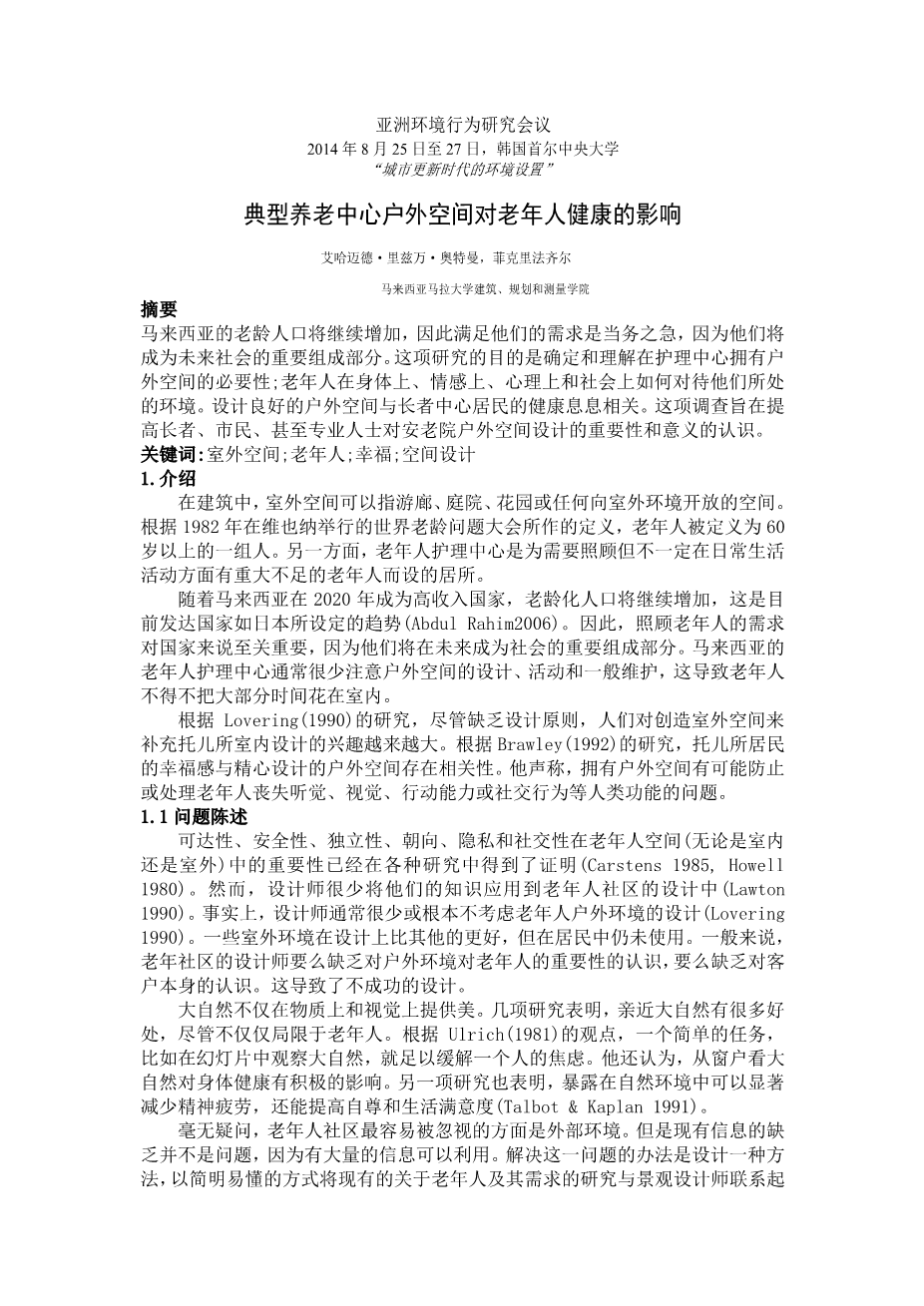“时渡”——南京五马渡滨江公共空间景观改造设计(公共交流空间)外文翻译资料
2022-08-06 10:10:42
Available online at www.sciencedirect.com
ScienceDirect
Procedia - Social and Behavioral Sciences 170 (2015) 320 – 329
AcE-Bs2014Seoul
Asian Conference on Environment-Behaviour Studies Chung-Ang University, Seoul, S. Korea, 25-27 August 2014 ' Environmental Settings in the Era of Urban Regeneration'
Influence of Outdoor Space to the Elderly Wellbeing in a Typical Care Centre
Ahmad Ridzwan Othman*, Fikri Fadzil
Faculty of Architecture, Planning and Surveying, Universiti Teknologi MARA , Malaysia
Abstract
Ageing population of Malaysia will continue to increase, hence accommodating their needs is imperative, as they will form a significant portion of the future society. The study was to identify and understand the need of having outdoor space in a care centre; how the elderly physically, emotionally, psychologically and socially behave towards their environment. There is a correlation between the wellbeing of residents of elderly care centre with a well-designed outdoor space. The investigation is expected to raise awareness amongst the elderly, public and even professionals regarding the significance and implication of having well-designed outdoor spaces at elderly care centre.
copy; 2015 The Authors. Published by Elsevier Ltd. This is an open access article under the CC BY-NC-ND license (http://creativecommons.org/licenses/by-nc-nd/4.0/).
copy; 2014 Published by Elsevier Ltd. Selection and peer-review under responsibility of the Centre for Environment- Behaviour Studies (cE-Bs), Faculty of Architecture, Planning amp; Surveying, Universiti Teknologi MARA, Malaysia.
Peer-review under responsibility of Centre for Environment-Behaviour Studies (cE-Bs), Faculty of Architecture, Planning amp; Surveying, Universiti Teknologi MARA, Malaysia.
Keywords: Outdoor space; elderly; wellbeing; space design
Introduction
In architecture, an outdoor space may refer to verandah, courtyard, garden or any space that is open towards the outdoor environment. Based on the definition made by the World Assembly on Ageing, in the year 1982 in Vienna, the elderly is defined as the group of people of age 60 and above. Elderly care centres, on the other hand, is a place of residence for elderly people who require care but not necessarily have significant deficiencies with activities of daily living.
As Malaysia progresses to become a high-income nation by the year 2020, the ageing population will continue to increase, following the trend set by current developed countries such as Japan (Abdul Rahim
* Corresponding author. Tel.: 60192241631; fax: 0-000-000-0000 .
E-mail address: dawn_arc7@yahoo.com
1877-0428 copy; 2015 The Authors. Published by Elsevier Ltd. This is an open access article under the CC BY-NC-ND license (http://creativecommons.org/licenses/by-nc-nd/4.0/).
Peer-review under responsibility of Centre for Environment-Behaviour Studies (cE-Bs), Faculty of Architecture, Planning amp; Surveying, Universiti Teknologi MARA, Malaysia.
doi:10.1016/j.sbspro.2015.01.042
2006). Hence, catering for the needs of the elderly now is crucial for the country as they will form a significant portion of the society in the future. Elderly care centres in Malaysia usually pay little attention to their outdoor spaces – in terms of design, activities and general maintenance – which result in the elderly having to spend most of their time indoors.
According to Lovering (1990), there is a growing interest in creating outdoor space to complement the interior program in nursery homes despite the lack of design principles. Based on the study by Brawley (1992), there is correlation between the well-being of residents of nursery homes with a well-designed outdoor space. He claims that having outdoor space has the potential to prevent or deal with the loss of human functions among the elderly such as hearing, vision, mobility or social behaviour.
-
- Statement of the problem
The importance of accessibility, safety, independence, orientation, privacy and sociability in elderly spaces, either they are indoors or outdoors, are already proven in various studies (Carstens 1985, Howell 1980). However, designers rarely apply their knowledge in designing communities for the aged (Lawton 1990). In fact, designers typically give little to no considerations to the design of outdoor environments for the elderly (Lovering 1990). Some outdoor environments are better design-wise compared to the others but remain unused among the residents. Generally, designers of elderly communities either lack an understanding of the importance of outdoor environments to the elderly population or lack an understanding of the clients themselves. This results in unsuccessful designs.
Nature not only provides beauty both physically and visually. Having nature in proximity has many benefits according to several studies, although
剩余内容已隐藏,支付完成后下载完整资料

英语译文共 21 页,剩余内容已隐藏,支付完成后下载完整资料
资料编号:[254971],资料为PDF文档或Word文档,PDF文档可免费转换为Word




